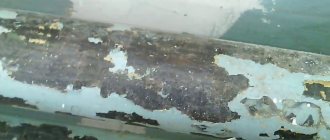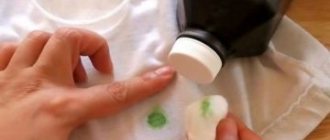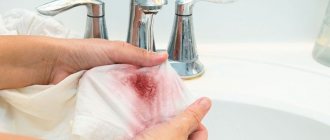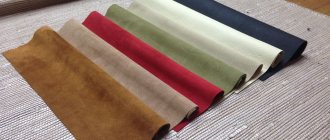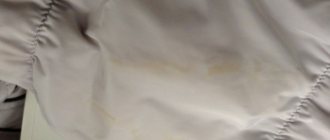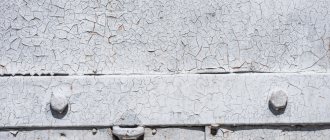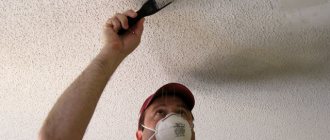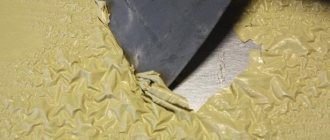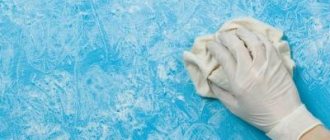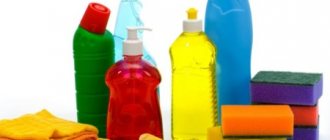The quality of surface cladding depends on the correctness of its preparation. At the first stage, the previous decorative coating is removed. Before you remove old paint from the ceiling with your own hands, you need to study the methods for performing this action and safety precautions.
It is very important to thoroughly clean the surface before many finishing works.
When is it necessary to remove the old coating?
When finishing the ceiling, the apartment owner is faced with a choice: leave the paint on or remove it. The first option is used when installing tension or frame structures. The supporting profiles are attached to the floor slab with dowels or other devices. The coating of the base does not matter.
In all other cases, paint removal is required. Old decorative coating impairs the adhesion of wallpaper or plaster. Over time, the decorative material comes off. Before applying a new layer of paint, remove the old one if it begins to crack.
How to Remove Acrylic Paint
This material is based on elastic and stable acrylic resin. Depending on what surface the paint is applied to, you can clean it using one of the following methods:
- Use hot water. For greater effectiveness, you can add a little soap and alcohol to it, since it destroys the structure of the material. The method works well if you need to remove acrylic from glass or plastic.
- A drill with a special coating removal attachment will remove it in layers. At the same time, the plaster will remain intact.
- You can try to remove the paint using sharp objects. Since acrylic is elastic, a regular knife will suffice.
- Special reagents are produced to dissolve acrylic compounds. When working with them, we must not forget about protecting the skin and respiratory organs.
Pay attention to: How and with what compositions a wooden fence is painted
If the repair involves applying new acrylic paint, it is not necessary to remove the old one.
Special nozzle for removing paint
What you need to know in advance
Before removing paint from the ceiling, you need to study the features of this work:
- The room being repaired is cleared of furniture, carpets and other interior items. When it is not possible to take everything out, use protective polyethylene film.
- If there are no plans to replace the floor covering, the floor is covered with newspapers or cardboard.
- When removing paint, a large number of small particles are formed, and chemicals contain toxic substances, so wear a respirator, work suit, gloves and a hat.
Tools and materials
To clean the ceiling from old paint you will need:
- step ladder;
- brush, roller, sponge;
- spatulas;
- chemical compositions for removing the decorative layer;
- individual protection means.
To clean the ceiling from old paint, you will need a stepladder.
Protecting the premises from pollution
After clearing the room of furniture, it is necessary to isolate already repaired elements that cannot be replaced:
- window frames and glass;
- lighting fixtures, switches and sockets;
- window sills
These items are covered with plastic film, and the joints are taped with masking tape.
Security measures
When cleaning the ceiling, observe the following rules:
- Work with solvents only in a respirator.
- The room should be well ventilated, for which all doors and windows should be opened. Otherwise, a person may be poisoned by toxic fumes.
- When using an electric tool, check the serviceability of the power cable and the functionality of the attachment.
When cleaning the ceiling, you need to wear a respirator.
Features of getting rid of whitewash
Having prepared the necessary equipment (stepladder, sponges, rags, bucket), covering the floor and pieces of furniture (if they could not be removed from the room), not forgetting to use personal protective equipment (robe, protective glasses, respirator), you can begin the process of cleaning the ceiling. There are several ways to quickly remove old whitewash.
We use water
To work, you need to prepare a spatula, a spray bottle with water and a rag . Using a sprayer, the ceiling surface is moistened.
With a break of ten minutes, the ceiling is moistened twice. After the whitewash layer has softened, it can be easily removed with a spatula. The clean surface is wiped again with a damp, clean cloth.
Do not wet the ceiling too much. Otherwise, during the removal process, the whitewash will flow down your hands and not come off in layers.
Newspapers with paste
To implement this cleaning method, you need to prepare a paste . To do this, dilute flour in a small amount of water (you should get a white liquid). Then pour the flour liquid into a separate pan of boiling water in a thin stream until a solution with a consistency resembling batter is formed.
The already cooled paste is spread over old newspapers, which are glued to the ceiling. Important: one corner of the newspapers must be left unglued. After the newspapers have grabbed the whitewash, with a sharp movement, grabbing a clean corner, they are torn off.
Along with the newspaper, the old whitewash will also be removed from the ceiling. Residues can be easily removed with a damp cloth.
Applying wash
In construction supermarkets you can purchase a special remover for removing whitewash.
It must be used strictly following the manufacturer's instructions:
- spray the product on the ceiling;
- wait until a crust forms on the surface;
- scrape off the crust along with the whitewash with a spatula.
A vinegar-soap solution can replace store-bought detergent (dissolve a spoonful of vinegar and two tablespoons of liquid detergent in 5 liters of water).
Basic Paint Removal Methods
Taking into account the means used, coating removal methods are classified into chemical, mechanical and thermal. The method is chosen based on the type of paint.
Chemical removal
You can soften the old coating using special compounds. Products contain alkalis, acids or solvents. They are used like this:
- The liquid is applied by brush, spraying or dipping.
- Repeat the procedure after 10-15 minutes (after an hour the coating softens).
- Remove the layer with a spatula or metal brush (sometimes the paint dissolves, it is washed off with water).
You can clean the old coating using compounds applied with a brush.
The chemical method is used when it is necessary to remove small stains of paint from flooring or fabric.
The products cope well with fresh stains. They do not dissolve paint applied several years ago.
Thermal method
The method involves heating the decorative coating until it softens. After this, the layer is removed with a spatula. For heating, use a hair dryer, a gas burner, or a blowtorch.
Heat treatment is effective, but it has disadvantages:
- it is impossible to use the method for removing decorative coating from plastic (most materials melt when heated);
- the use of devices that create an open flame in the room is undesirable;
- Acrid smoke released when paint burns causes poisoning;
- The thermal method cannot be used for all surfaces (it is practically ineffective when working with massive metal structures).
The thermal method involves heating the paint.
Heating with a construction hairdryer is used to clean painted wooden objects.
The thick decorative layer swells and is quickly removed. The surface becomes ready for repainting.
The operating technology is simple:
- Hold the heating device with one hand. Direct fire or hot air to the surface.
- Move the device as the decorative layer softens. Use your other hand to remove the cracked paint using a spatula.
Before cleaning windows and doors, remove the glass from the frames, dismantle the fittings, and wipe the surfaces. It is not possible to remove the coating from a concrete or brick wall using heating.
Mechanical paint removal
In this case, the surface is treated with an electric or manual tool. The most common device is an angle grinder, commonly called a grinder. The disc is replaced with a special brush or petal attachment. Metal surfaces are cleaned mechanically.
Mechanical paint removal occurs using hand tools.
Sometimes the grinder is replaced with a simple drill equipped with a steel brush. However, working with such a tool is not entirely convenient. There are also chain attachments that are inserted into the drill chuck.
Specialized devices are surface grinders and milling cutters. The latter are used for treating concrete, stone and plastered surfaces. They cannot be used for metal.
Surface grinders are not suitable for removing oil-based paints. However, they remove water-based compounds well.
Instructions for removing different types of paints
Some coatings can be easily removed from the base. However, it is difficult to remove old compounds, such as oil ones.
Oil dye
The main property of such compositions is good adhesion to the surface. To wash off, use reagents or folk remedies.
Oil dye adheres well to the surface.
Before removing ceiling paint, prepare the following materials and tools:
- chemical remover;
- soda ash or caustic soda;
- chalk;
- slaked lime;
- metal brush;
- putty knife.
The reagent is used to clean freshly painted objects. The following methods can also be used:
- Homemade remedy. Slaked lime, chalk and caustic soda are mixed in a ratio of 1:1:1. The substances are diluted with water to a paste consistency. The mixture is distributed over the surface. After a few hours, the paint is removed with a spatula.
- Heating with a construction hairdryer. The method helps to avoid the use of toxic removers, but the surface will have to be treated for a long time.
Acrylic composition
To remove such compounds, use sandpaper or a grinding machine. When removing paint from wooden ceiling structures, use a knife or chisel. The acrylic coating is removed from plastic panels with a hot soapy solution. Adding alcohol helps to complete the task faster. If it is necessary to re-apply the acrylic composition, the surface does not need to be cleaned.
To remove the acrylic composition, use sandpaper.
Water-based paint
To remove such a composition from the ceiling, perform the following steps:
- Thoroughly moisten the surface to be treated. The most convenient tool is considered to be a roller with a needle attachment. It leaves marks that make the paint removal process easier. If drops drip from the ceiling when wet, the surface has been treated with a waterproof compound. It is more difficult to soften such material.
- Leave the coating on for a few minutes. This is necessary to saturate the entire layer.
- After softening, the composition is scraped off with a spatula. The tool is held at an angle to avoid damaging the plaster.
Removal by wetting can be replaced by using a grinder. It quickly removes the water-repellent coating. However, during operation a lot of dust is generated.
Experienced finishers use the following method to remove the old decorative layer:
- Prepare PVA glue and newspapers. Apply the product to the ceiling with a roller and cover the surface with paper.
- Wait for the glue to dry. Remove newspapers by hand or with a spatula. The paper comes off, and along with it the layer of water-based paint is removed.
It is convenient to remove water-based paint with a roller with “antennae”.
Removing whitewash
The thick layer of material is removed in stages:
- Moisten the area of the surface to be cleaned with warm water in advance. Leave the coating on for half an hour. The whitewash softens and begins to peel off.
- Remove the material with a narrow metal spatula. The surface is thoroughly cleaned, leaving no traces of whitewash.
To remove a thin layer of whitewash, the ceiling is sprayed with water using a spray bottle.
Remove the whitewash with a spatula, check the treated area for the presence of material residues. Any imperfections should be wiped off with a damp sponge.
Waterproof paint
You can clean this coating with a grinder. To prevent dust from forming during work, the surface is thoroughly wetted. You need to work with gloves and a mask, using a medium-hard brush.
You can clean waterproof paint with a grinder.
Removal is done like this:
- Treat the ceiling with a wet roller. Clean the surface with an electric tool.
- Residues should be washed off with a sponge.
An equally effective method is heating with a hair dryer. You will also need a sponge, a wire brush, and a spatula. You need to wear a respirator; when heated, the coating begins to emit smoke.
Cleansing is done like this:
- Warm up a small section of the ceiling with a hairdryer. High temperature helps soften the composition.
- Remove the coating with a spatula. You can remove paint residues with a wire brush.
The hair dryer should not be used in places where electrical wiring is close. Heating can melt the braid, which can lead to a fire.
Removing water-based paint
Water-based coating is one of the most popular. The advantage over other types is that it is easy to remove. Before removing old paint from the ceiling, prepare a bucket of warm water, a roller or brushes, and a wire brush. Next, follow the following procedure:
- To get rid of a layer of paint, wet the entire ceiling well with warm water. To apply it, you can use brushes or a roller. But the fastest way to do this is with a sprayer. There is no need to wet the entire surface at once, as it will dry quickly. It is better to first apply water to 2-3 square meters of area.
- Allow the liquid to soak into the coating. This will take about 10-15 minutes.
- After this, clean the ceiling using a spatula. It should easily remove the wet coating. Use a scraping motion and keep the tool parallel to the surface. This is necessary in order not to damage the ceiling itself.
- Finally, wipe the ceiling tiles with a cloth to remove any remaining paint.
Please note: We paint a rose with our own hands in the desired color
If the coating was applied in several layers, it will be more difficult to get rid of it. To do this, you will need to spray water not just once, but 3-4 times. Do this at intervals of about 10 minutes. After applying the final layer, leave it for another 15 minutes and then begin to clean it with a spatula. In areas where the paint is applied in several thick layers, it may not soak well enough. To remove, you can use a metal brush rather than a spatula. There are other ways to remove old canvas. For example, you can clean it with a sander. The advantage of this method is that no time is wasted on soaking the coating. Disadvantage: when processed with a machine, a large amount of fine dust will settle in the room. It won't be easy to clean. In addition, you can use the classic method. You will need a lot of newspapers and glue (PVA or regular wallpaper). It is applied in a thick layer to paper and then glued to the ceiling. There is no need to touch it until the newspaper sticks and dries completely. Afterwards, the paper layer is removed along with the remaining paint. It should come off easily, but if you have difficulty, use a spatula. You can sand the ceiling and finally level it using sandpaper.
Special solutions can be used to remove paint
Washing off a suspended ceiling
The following products are suitable for removing water-based or acrylic paint:
- Gel for the care of stretch ceilings. The product is not cheap, but it quickly copes with such stains.
- Soap solution, dishwashing liquid. Saturate a sponge or napkin with the product, wash off the paint, making light movements back and forth. You will have to erase the marks several times.
- Hydrogen peroxide. Moisten a soft cloth with a 3% solution and wipe off the stains.
Gels or soap solution are suitable for removing paint from a stretch ceiling.
It is more difficult to remove oil paint from a canvas. It is not advisable to use mechanical methods - the tool can damage the ceiling. Solvents are used for removal, such as gasoline, turpentine, kerosene. Before you wash a stretch ceiling of paint with one of these products, you need to study the features of the canvas. Some materials become discolored or damaged when exposed to solvents.
How to remove paint from a ceiling that has rust
In this case, the work is done like this:
- Remove the old coating. To do this, use one of the previously described methods. The coating is removed to the base - concrete or drywall.
- If rust stains remain on the floor slab, prepare a solution of chlorine bleach (the product is diluted with water in a ratio of 1:1) or copper sulfate (the substance is mixed with liquid in a ratio of 1:4). Moisten a sponge with the prepared mixture, which is pressed against the rust stain for 5 minutes, after which it is rubbed in a circular motion.
- Large rusty stains are removed in several stages, treating sections one at a time.
When working with bleach, the stain should lighten; applying copper sulfate promotes the appearance of a greenish tint. This means that the ceiling is ready for repainting.
How to quickly clean a ceiling from water-based paint?
Water-based paint has long become one of the favorite finishing materials of craftsmen of any skill level. Any painter can handle the painting, because applying water-based emulsion is quite simple. In addition, this type of finishing material has many advantages:
- Environmentally friendly.
- Strength.
- Durability.
- Excellent vapor permeability.
- Easy to use.
- Possibility of use in any premises: residential, utility, industrial.
- Dyes allow the material of walls and ceilings to breathe.
- Prevents the formation of mold.
But the advantages of water-based paint play a cruel joke: removing the coating is quite difficult.
Inventory
To clean the ceiling from water-based paint quickly, you will need the following tools and materials:
- Protective glasses.
- Respirator.
- Ladder.
- Set of spatulas.
- Large foam roller.
- Water container.
- Telescopic rod.
- Ditch for wetting the roller.
- Film for covering floors and furniture.
- Old newspapers.
Let's divide the entire cleaning process into several stages.
Preparing the premises
The process of cleaning the ceiling is a very dirty job, so in order not to spoil the floor and furniture, and also to protect yourself:
- Everything that can be taken out of the room, take it out.
- Cover the floor and furniture with film.
- Cover the floor in two layers, laying the film crosswise. Do not forget that you will move around the room standing on a stepladder, and its legs will push the film apart and scratch the floor.
- Throw a generous amount of old newspaper onto the film. As you work, periodically remove the paper, along with the dirt, so that there is less debris.
- Wear personal protective equipment: gloves, goggles and a respirator.
What not to do
Some actions cannot be performed when washing off paint.
Main restrictions:
- Do not use open fire to remove oil paint. This increases the likelihood of the surface and surrounding objects catching fire.
- Water-based coatings cannot be removed with a grinder or drill, otherwise the plaster layer may be damaged, which will have to be restored by repeated puttying.
- The use of sharp objects such as knives is prohibited. The blade, along with the paint, removes the plaster.
Recommendations from the experts
The paint must be completely removed. Even small areas of the old coating lead to the appearance of cracks, streaks and bubbles on the new layer.
When removing whitewash, you need to determine its type. The chalk composition quickly absorbs water. If the ceiling is covered with lime whitewash, the liquid will not be absorbed.
Chalky material can be easily removed with plain water. Mechanical methods are used to remove lime coating.
When using water, work is carried out gradually. While removing paint from one area, other areas may dry out. In this case, wetting will have to be repeated.
How to remove waterproof paint
Cleaning waterproof paint from a surface is usually not easy. It is not affected by liquid, since the material creates a kind of protective layer on the ceiling. If you don't know if it is waterproof, check by trying to wet it with water. If after a few minutes the coating does not peel off, then you need to use radical cleaning methods. First of all, you need to destroy the structure of the paint. To do this, you need a hard metal brush, which you need to go over the entire ceiling. Try to leave as many scratches as possible. Then wet the surface with water. Repeat the procedure several times until the material swells and begins to peel off. Then it can be removed with a regular spatula. In addition, you can use standard methods:
- heat the coating with a hair dryer;
- go through it with a drill;
- Apply regular glue diluted with water in a thick layer and leave until dry.
Removing paint using a hair dryer
